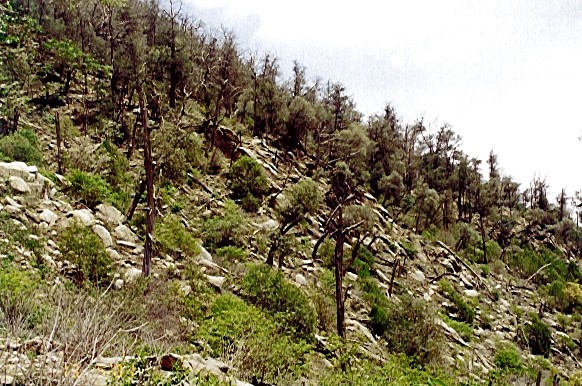Impact on Ecosystems

Prolonged droughts have serious repercussion on various ecosystems in Saudi Arabia. If there is no rain, ground water level will fall considerably, wet-land areas and the seasonal springs in highlands and wadis will dry up. As a result of these impacts there will be a drastic change in the vegetation cover and this will affect the infiltration rate, increased run off and soil erosion and a decline in ground water recharge. Natural ecosystems identified as being at risk in Saudi Arabia include wadis, rivulets, various woodlands in mountains, wetlands, raudhas, coastal areas, etc.
In some cases, such as in coastal areas, habitat may simply be lost as a result of factors such as sea-level rise, with no potential area for species to migrate. Farasan group of islands, off Jizan coast is one of the finest habitats for two important mangrove spp. (Avicennia marina and Rhizophora mucronata). These islands are also a resting place for a number of migratory birds such as sooty Gulls, Black headed Gulls, Boobies, Terns, Egrets, Pelicans, etc. The coastal mangrove forests also provide a breeding ground for a number prawns and fish. The presence of these mangrove communities and birds may be threatened by the disappearance of coastal marshes as a result of increases in sea level from global warming.
Species occurring in the Hijaz Mountains are also at risk of losing habitat as a result of changes in climate. Extreme temperature conditions may cause these areas to undergo major changes, to an extent due to high rates of variation in habitat structure that naturally occur on mountain ranges as a result of changes in steepness, slope and exposure. Besides loss of habitat, wild species are at risk from fire hazards. It is now well known that the kind of vegetation in a region is the basic factor involving all types of fire hazards. Other main factors to be considered in fire-hazard potential are the relative humidity and temperature. Many dominant grass species such as Themeda triandra, Cenchrus ciliaris, etc. are dominant in areas of high species density. Dried plants of such species are a tremendous fire hazard.
The rangelands and their components are the most important natural resource in the Northern parts of Saudi Arabia. After establishing several protected areas, a range monitoring programme has been started by the Range and Animal Development Centre at Al-Jouf to determine the effects of climate and the recovery of vegetation. Their study shows that despite the prevention of grazing, the vegetation in several areas (except Harrat Al-Harra) remain as stunted, primarily due to lack of rain and extreme heat. The system used by the investigating team could be utilized by range managers to adjust livestock numbers according to the range trend.
In most parts of Saudi Arabia, the term ‘rare plants’ has an important significance when referring to the flora. It is basically due to rainless years, severe heat and the unsustainable use of natural resources. In many countries, the rare plants constitute only 5-15% whereas in Saudi Arabia, the rare category which also includes the endangered species constitutes about 33%.
Anticipated negative impacts of climate change on woodlands of Saudi Arabia over the next 50-100 years include:
- Increases in the frequency and changes in the patterns of natural disturbances such as fire.
- A shift toward a younger age class structure of the woodland,
- A reorganization of woodland species composition.
- Major changes occurring along woodland and species-rich area boundaries, particularly in the southwestern and northwestern regions.
- Woodland decline in species rich areas due to slower dispersal capabilities of plants.